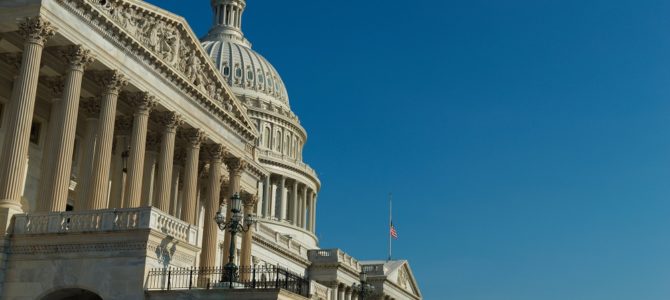
The recent burst of leftist policy initiatives consume our current political discourse, with the apotheosis being the so-called Green New Deal, a compendium of projects to not only stop climate change, but to transfer full control of the entire economy to the leftist elites who run the Democratic Party and the permanent bureaucracy of our central government.
It is not surprising that these elites look to the era of the Great Depression and World War II as models for their agenda (except with every day meatless instead of one day a week). While the common people were then subject to deprivation, impoverishment, and rationing, they were also wholly subjugated to the dictates of an earlier leftist elite. Good times indeed.
Ill-conceived, unfeasible, and highly deceitful, such sweeping leftist fantasies make conservatives leery of any grand program. However, we conservatives will never achieve our purported goals without our own grand programs. One hopes that they would be far better conceived, genuinely doable, and honestly presented. To borrow from Madison, we must match ambition with ambition.
The Ever-Expanding State
For more than 100 years, since the presidency of Woodrow Wilson, the central government has been expanding. Sometimes the pace slows, but the growth of central government power (and concomitant debt) has continued relentlessly for those hundred plus years.
Even when President Trump called for two regulations to be repealed for each new one created, he was only nicking away at the top of the tower. If we try to dismantle the behemoth one regulation, one short-term agency head, one state-oriented but federally directed program at a time, the behemoth will stand until it disastrously collapses under its own weight of debt and misrule.
Of course, there is no one magic bullet to fell the beast. However, two major things could drive our central government back into its proper constitutional bounds.
For one, whatever happened to block grants? For as long as I have been aware of political matters (and I am not young), Republicans have been proposing eliminating large federal welfare bureaucracies and––recognizing the federal government’s greater access to tax revenue––providing unrestricted federal funds to the states to accomplish the eliminated departments’ aims.
This was supposed to happen to the Department of Education under Ronald Reagan. Reagan, of course, was limited by a Democrat-controlled House, but even when Republicans had full control of the elected branches, they instead doubled down with lavish expansions like No Child Left Behind. Even when we can have a courageous Secretary of Education like Betsy DeVos, as long as the laws, budget, and permanent bureaucracy persist, new expansion is inevitable once there is a change of administration. The bureaucracy will always find ways to justify its existence.
Our nation is the third most populous on the planet, far more diverse and many times more populous than the tiny homogenous northern European social democracies that much of the left is constantly telling us we must emulate. Rather than massive, inefficient, one-size-fits-all centralized programs, our huge and heterogenous nation needs a multiplicity of diverse approaches to address our social challenges. Even if it is not politically feasible at present, block grants to replace the entirety of federal bureaucracies and their underlying statutes should be the only conservative national agenda for education, health care, poverty alleviation, and other social ills.
Return Constitutional Order to the Administrative State
Another vast expansion of centralized power is the proliferation of independent administrative agencies. Many have taken to referring to them as the “fourth branch” of the federal government. Congress has delegated the power of all three constitutional branches to them. They make their own laws, administer them, and enforce them through their own internal judicial systems, in which their own employees both prosecute and adjudicate infringements of their regulations.
They are theoretically subject to the Article 3 courts, but the so-called Chevron doctrine requires the courts to defer to the agencies’ interpretations of the regulations they have created. The entire system violates the most basic constitutional principles of separation of powers, but the Supreme Court has so far acquiesced in Congress’s divestiture of its responsibilities.
These agencies are generally controlled by the corporations they are supposed to regulate, who use them to put regulatory burdens on their smaller competitors. Staffed by largely Democrat bureaucrats who move between the agencies and lucrative compliance jobs with lobbying firms and the regulated, the administrative state is a major sources of the corporate power and income inequality which is claimed to so distress the left.
The Congressional Review Act law allows Congress to repeal agency regulations for a short time after their promulgation. The Republican-controlled 115th Congress used to this to revoke a few regulations enacted at the end of the Obama administration. However, this entire system is a creation of Congress. There is no provision of the Constitution empowering this extra-constitutional soup of alphabet agencies. Rather than give itself a meek, time-limited right to repeal agencies’ enactments, it is wholly within Congress’ power to revoke the entire sorry system.
With one law, Congress could repeal all independent agencies’ authority to make regulations. The agencies could remain in place to research and draft regulations, but proposed regulations would all then have to be sent to Congress to be confirmed by both the House and the Senate before they would have the force of law.
There certainly would be complaints that this requirement would gum up the administrative state’s operations, but that would be the point. It would restore constitutional control and accountability to the largely uncontrollable and unaccountable bureaucracies of the administrative state. Democracy is not efficient, but it is right.
Again, these are just illustrations of how bold steps could reduce our century-old centralization of power. We don’t just need a mirror of Democrats’ expansive new programs. To mobilize the support necessary to regain the ground lost in 2018 and win big in 2020, Republicans have to offer something more visionary than diluted piecemeal alternatives to the leftists’ agenda.
Discussing the perceived conflict between conservatism and populism, Sen. Mike Lee has argued that the “best path forward for Republicans, then, is for conservatives and populists to work together on a new synthesis––a reform agenda that would be more substantively useful and politically appealing than either side’s default platform.”
For such a reform agenda to be effective, it must also be ambitious in extent and scope. Without that, the leftist elites will prevail again, and visit even worse misery on our nation than that which was inflicted on us in the ’30s and ’40s.









